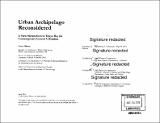Urban Archipelago reconsidered : a new metabolism in Tokyo Bay for contemporary coastal urbanism
Author(s)
Oktem, Caner
DownloadFull printable version (22.39Mb)
Alternative title
New metabolism in Tokyo Bay for contemporary coastal urbanism
Other Contributors
Massachusetts Institute of Technology. Department of Architecture.
Advisor
James Wescoat and Fadi Masoud.
Terms of use
Metadata
Show full item recordAbstract
Coastal areas are home to more than half of the world's population and many of its most populated urban areas. Coastal urbanism remains very much in demand despite major risk factors such as sea level rise, longterm shoreline erosion, storm surges, land liquefaction, and subsidence. City-building on reclaimed land is an ambitious form of development yet prevalent around the world, especially where an economic growth agenda is pursued aggressively against the availability of land resources. This thesis develops a critical design agenda to respond to how pro-growth forces and environmental change can be negotiated towards a reconsidered coastal urbanism. The thesis argument is that coastal urban and territorial form should not follow a static master plan based on a risk model; instead, it should employ/follow a dynamic gradient of permanence and ephemerality in multiple time scales, following coastal succession as a design analogy. Tokyo Bay is the site of experimentation. The world's largest metropolitan area has a long history of land reclamation debates and projects, which resulted in a highly articulated urban coast with reclaimed shorelines, and near- and off-shore artificial islands with a mix of uses. The on-going construction of the urban archipelago is an outcome of urban and regional metabolisms, where incinerated solid waste, dredged sediment, excavated soil, and demolished buildings are deposited to make new land. Demand for post-industrial urban development and land reclamation is still alive in coastal Tokyo despite the vulnerabilities of flooding and seismic events. Large waterfront sites are now available for new development. The construction of permanent and temporary facilities in Tokyo Bay for the 2020 Summer Olympics offers an opportunity to develop a succession- based design strategy-not only for the 2020 peak condition, but also in anticipation of future transformations. The design exploration establishes, via strategic cartography, a resiliency district framework based on a gradient of permanence and flexibility in the ground condition. The sharply delineated boundary between land and sea is rethought as a dynamic frontier zone of flexibility that adapts to flooding and sea level rise and as an active site for coastal deposition and submersion. A second, elevated ground level is proposed to serve as a pedestrian and emergency thoroughfare, as well as an extension of transportation and logistics infrastructure. The Metabolist imaginary envisioned Tokyo Bay as a site of continuous urban growth towards a mega-scale climax state; ground was taken for granted and the possibilities of urban decline or reconstruction were hardly considered within the same design utopia. This project argues for a New Metabolism in which the ground is conceived as an indeterminate landscape of change. The uncertainties of the ground are addressed by an 'artificial land' infrastructure which organizes and facilitates transformation over time.
Description
Thesis: S.M., Massachusetts Institute of Technology, Department of Architecture, 2016. Cataloged from PDF version of thesis. Includes bibliographical references (pages 133-145).
Date issued
2016Department
Massachusetts Institute of Technology. Department of ArchitecturePublisher
Massachusetts Institute of Technology
Keywords
Architecture.